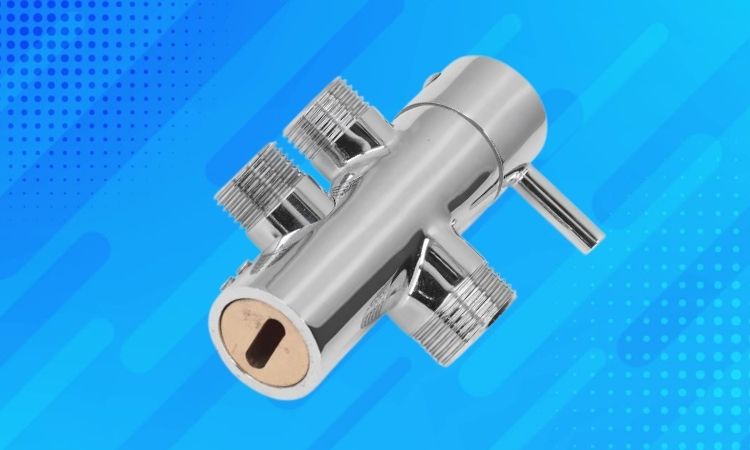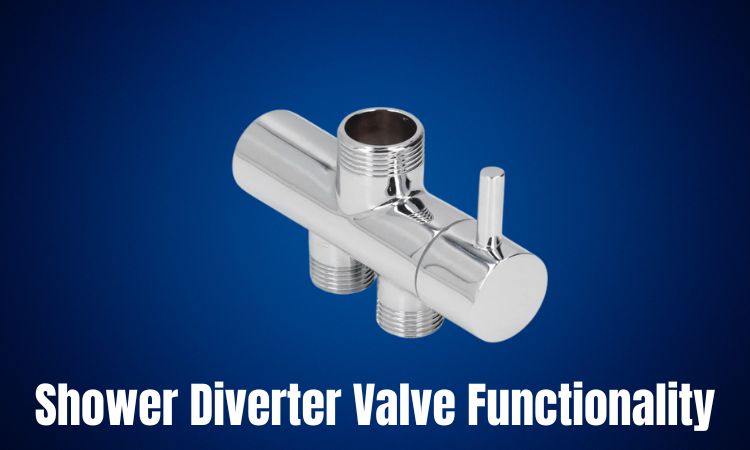Shower diverter valves are now the most popular addition in bathroom plumbing fixtures, highly used in hotels or households as well with modern bathroom configurations. But this broader popularity among the users left in wondering how does a shower valve work.
To simplify, the diverter valve equips a specialized plumbing mechanism that allows users to switch the flow of water between different shower fixtures like shower heads, hand showers, and tub spouts. When you turn the handle or toggle the control, the internal seals block one pathway and redirect the incoming water supply to your desired shower outlets.
Not enough information on the shower diverter valve functionality, right? Let’s dive right in and learn many more unknown facts about this shower valve system, along with its types and expert tips for operating it.
Table of Contents

What Is A Shower Diverter Valve?
If you have a standard bathtub and shower combination in your bathroom, a shower diverter valve is a crucial addition for directing the flow of water between the tub faucet and the shower head.
Here the diverter valve acts as a switch, allowing you to change whether water is directed up to your shower head or out of the tub faucet. Typically, a control handle that you turn or pull to divert this water flow.
This ability to switch between bathtub and shower functions using a single fixture is more space-efficient than having separate enclosures. Even it’s an elegant solution that saves your money also as you only need one set of plumbing and water lines instead of two fully separate systems.
Exploring Different Types Of Shower Diverters To Control The Flow
If you are remodeling your existing shower system and looking for a shower diverter type, let me clarify you’ll get confused here for sure.
There are a dozen shower diverters available in the market, made with different features and benefits.
For your convenience, here I am listing the common and popular 5 types of shower diverters that most house owners use:
1. Single Valve (Or T) Diverter
This is a single-valve diverter that has only one handle to control and divert the water between two outlets, most commonly the showerhead and bathtub faucet. The diverter is shaped like a “T”, offering a very straightforward option to manage the water flow.
2. 2-Way Shower Diverter Valve
A 2-way diverter is the most common diverter type that is designed to redirect the water flow between two outlets. It diverts a single stream of water between two ports either from the showerhead to the bathtub faucet or handheld shower.
Most commonly they are built into the wall and controlled by a trim from which you divert the water flow.
3. 3-Way Diverter Valve
This type of diverter valve incorporates 3 outlets which allow users to divert the water flow between them as their preferences. Typically, the type of 3-way diverter is versatile and can be used in various options.
The most common one includes showerhead, handheld, and tub spout. Most users use it in body sprays or rainheads as well.
4. Push Button Shower Diverter
The push button diverter is a different type of diverter, equipping push only or push & pull to divert the water flow between two outlets. This type of diverter valve comes with a pre-installed pressure balancing valve.
After pressing the button, it internally shifts the valve to redirect the water flow.
5. Integrated Diverter:
An integrated diverter is built in with the existing handle of the shower valve trim. It comes with a sliding or dial mechanism that could either hang from the main handle or be positioned on top or behind the control.
This is the most versatile and functional diverter type than the push button option.
The Working Mechanism Of Shower Diverter With Diagram
The shower diverter valve mainly controls the direction of water flow from one outlet to different shower outlets like shower heads, hand showers, body sprays, etc. In this bathroom plumbing system, water pipes connected with one outlet also extend vertically to the showerheads.
And inside the valve, there is a rotating stem that is attached to the external handle or push button. When the handle turns or the button presses, the stem turns and aligns internal channels to direct water to the selected outlet port.
Then rubber seals or springs inside the valve body block water from going to the unused outlets. You just need to operate the external handle or button to activate the internal stemming and allow water to flow to your desired water fixtures.
See the shower diverter diagram below for a better understanding:
Still, confused? Let me explain with a simple shower diverter example:
This is a tub spout diverter that comes with a pin or knob, installed vertically or most often horizontally with the tub spout body. Inside is a chamber of two outlets with one water pipe – one leads upwards to the tub spout, and the other connects to the shower riser.
i) As with turning on the water supply, water enters from the supply line into the tub spout and makes the pipeline full.
ii) As soon as you press the pin or knob down, the inside seal focuses the water coming out from the tub spout.
iii) And when you lift up the knob, the inside seal blocks the pathways of the tub sport and redirects the water flow to the showerhead and that is how simply it performs.
Ultimate Benefits Of Using A Diverter Valve in Your Bathroom Plumbing System
A shower diverter valve provides important functionality and convenience in controlling water flow. There are some more key reasons, defining the crucial role of the shower diverter valve in your shower setup:
1. Enhanced Shower Experience:
A diverter allows switching between different shower heads and functions like a fixed handheld, rain shower, and body sprays. This flexibility of the shower options allows you to choose your preferences.
All that will improve your shower experience & ultimate satisfaction compared to a fixed single shower.
2. Easy Flow Control
With just a flip of a handle or press of a button, you can easily direct water to different shower fixtures. This ensures convenience and ease of use by quickly redirecting the water flow to your desired port whenever you want.
3. Maintain Consistent Temperature:
If you have a thermostat shower diverter, it will help you control the temperature as well as the stream of water flow. This safeguards you from frequent temperature changes in the water supply and ensures a comfortable and consistent shower experience.
4. Water Saving:
The diverter valve allows you to control the water flow and only redirect it to your desired outlet without any chances of water leakage. This helps reduce unnecessary water usage compared to letting multiple fixtures run together for the entire shower.
For example:
You want to wash your hair. Turn on the rain shower fixture above to wet your hair completely. Then turn it off and use the targeted spray of the hand shower just to rinse the shampoo out of your hair rather than leave the overhead rain shower running.
5. Quick Repair & Installation
Shower diverter valves are installed in an accessible location, allowing straightforward inspection, testing, and servicing without any hassle. Plus, the valve consolidates control into one body rather than requiring multiple valve components. This compact design is easier to fit and connect.
How To Operate A Shower Diverter Valve?
Shower diverter valves are designed for very easy and intuitive operation but it depends on the type of diverter valve you’ve installed. Typically, it comes with a single handle that rotates or a push-button that toggles to divert water. That is quite easy to understand and use.
If you are new, here are the basic steps you should know to operate a shower diverter valve:
- Start by turning on the water supply to the main shower valve to start the water flow from the existing outlet.
- Now locate the diverter valve and understand its operating mechanism. If it’s a handle, turn it clockwise or counterclockwise to the desired outlet position.
- And if it’s a button, push it in to toggle and switch flow. In case, the diverter valve is stuck, you will need to inspect it for any obstruction and mineral buildup.
- Check that the water is now flowing from the selected shower outlet. If needed, use a shower mixer to fine-tune the water temperature.
- If you want to switch the water flow between the different outlets or combinations, just turn the handle or press the button again and enjoy.
[Tips: Always turn the diverter valve to the off position when finishing showering before turning off the main valve]
- In case of any malfunctions with the diverter valve, our comprehensive troubleshooting guide will assist you best in dealing with the issue.
Difference Between A Diverter Valve & Shower Valve
Though the terms shower valve and shower diverter valves seem similar and still some users assume that both are the same and have similar functions. But no! There is a huge difference between them.
The shower valve simply regulates the water flow and temperature changes of the shower. As the name suggests, the diverter valve is designed to direct the water flow to one outlet blocking the pathways of another one.
Plus, a diverter uses a handle, knob, or button to redirect water. A shower valve uses knobs and/or cartridges to control volume and temperature.
In the case of location, a shower valve is installed on the supply lines behind the wall whereas a diverter valve doesn’t require access behind walls. It is located on the shower arm, head, or tub spout as per different models.
Essential Tips To Maintain Your Shower Diverter Functionality In Top Condition
To ensure convenient operation and prevent issues, it’s a good idea to periodically service your shower diverter valve. This will keep it working properly for years to come.
Here are some essential maintenance tips you should follow:
#Remove debris buildup – Periodically inspect your diverter valve for scale build and it is a crucial step if you are living in a hard water area. Use a mild descaler or vinegar solution to remove the scale build-up.
#Lubricate components – After cleaning, use silicone grease on the handle stem and o-rings to prevent binding and allow easy turning. Avoid petroleum-based lubricants.
# Check for leaks – Inspect around the handle and outlet connections to make sure there are no water leaks that could indicate worn seals. Water leaking means your diverter needs repair.
#Replace worn-out parts- Over time, it is quite common that the internal rubber seal or plastic part may be worn out. If you notice difficulties in operating the valve, be sure it is time to replace the damaged part.
#Be moderate in operation – Avoid excessive force or over-rotating when turning the handle. Turn smoothly without jerking to prevent internal damage.
FAQs:
What to do if my shower diverter valve pin comes out?
If the pin comes out of your tub spout diverter valve, first shut off the main water supply. Take the diverter apart and carefully realign the pin into the correct position in the valve body and then turn the water back on. Test the diverter function before using the shower.
What is the purpose of a 4-way diverter valve?
The purpose of a 4-way shower diverter valve is to allow switching the water flow between 4 different shower outlets using a single valve. Water enters from one inlet and then diverts the water to each outlet as your selection.
Are there any disadvantages of a shower diverter valve?
The only downside you may notice a drop in water pressure while diverting water in different outlets. Also, at times, switching flows between hot shower heads and cooler tub spouts can cause fluctuations in water temperature.
In Closing!
When it is the fact about versatility options while showering or enhancing the shower experience, a shower diverter valve truly matters. The simple toggle of a handle gives you convenient control to customize your shower. Isn’t it amazing?
But how does a shower diverter work? After thoroughly reading our article, hope you are clear now. So, if still you don’t make it a part of your shower plumbing system, it is the right time to do so!
Installing a quality diverter valve will not only provide you the flexibility but also improve the showering experience that you have enjoyed ever.


About Atikul
Atikul Islam shares his expertise with various tips & tricks to fix the problems with home appliances related to toilet, kitchen, bathroom, heating, & cooling systems. Read to know more about Atikul Islam.